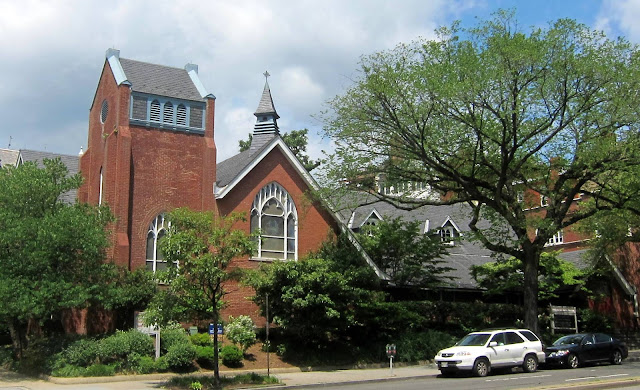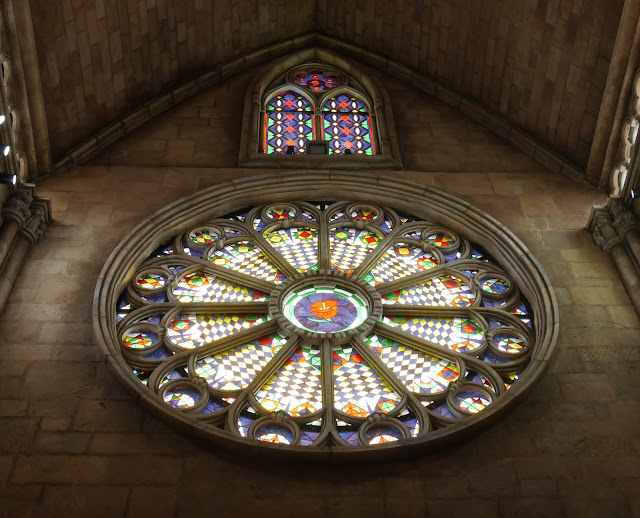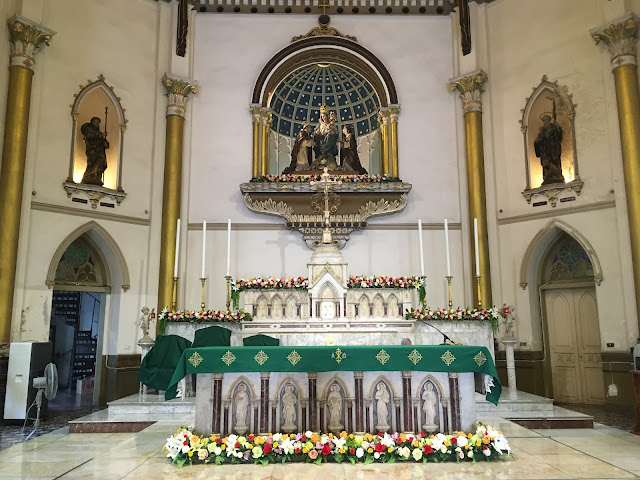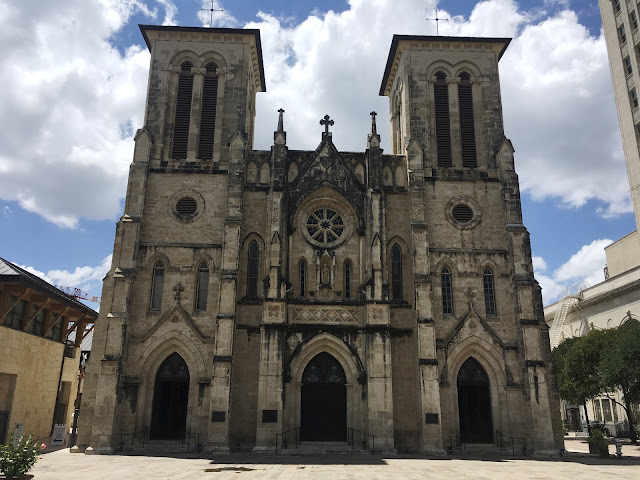The pronoun for God is God: seeking inclusion through liturgy
 |
| stained glass window at St. Margaret's Episcopal Church - photo used with permission from St. Margaret's Episcopal Church, Dupont Circle, Washington, D.C. |
Sacred Spaces #3
The pronoun for God is God: seeking inclusion through liturgy
St. Margaret's Episcopal Church, Dupont Circle, Washington, D.C.
by Kyle Desrosiers
 |
| exterior of St. Margaret's Church, Washington, D.C. - photo used with permission from St. Margaret's Episcopal Church, Dupont Circle, Washington, D.C. |
Originally written and published in June 2019
A few weeks ago I spent four days in Washington, D.C. The main purpose of the trip was to attend the Opening Conference for the Shepherd Higher Education Consortium on Poverty, a poverty studies fellowship for undergraduates. I was a participant in the S.H.E.C.P. last summer and am currently serving as a communications intern.
 |
| St. Margaret's Episcopal Church, an urban parish. This image deceitfully makes the church look like it is not surrounded by countless buildings, people, traffic, and smog– which it most certainly is. |
I spent a few extra days in the D.C. area to work on research for my undergraduate thesis, a project about HIV care in faith-based communities. I was in D.C. on a Sunday, so I opted to attend the 10:30am Eucharist service at St. Margaret's, an Episcopal parish church in Dupont Circle.
St. Margaret's celebrated the Eucharist with the Rite II liturgy, taken from the Book of Common Prayer. This liturgy was unique, however, as it had been thoughtfully amended to be gender neutral.
There is a sound tradition of Biblical criticism which protests the use of male pronouns and masculine descriptors of God. Though much of Christendom still uses masculine imagery of God in its liturgy and prayers, many mainline Protestant groups have begun challenging any notion that God has gender at all. God transcends gender, they argue. God is male and female and genderless and everything in between– reflecting the diversity of creation that is perfectly made in God's image.
There is a sound tradition of Biblical criticism which protests the use of male pronouns and masculine descriptors of God. Though much of Christendom still uses masculine imagery of God in its liturgy and prayers, many mainline Protestant groups have begun challenging any notion that God has gender at all. God transcends gender, they argue. God is male and female and genderless and everything in between– reflecting the diversity of creation that is perfectly made in God's image.
This paradigm shift calls for a reconsidering of many existing worship practices. Many parishes, such as St. Margaret's (which is located in the Dupont Circle neighborhood with a large population of LGBTQ Christians) have implemented liturgy which has been adapted to be inclusive of human diversity.
 |
| A shrine for veterans at the Washington National Cathedral, the flagship church of the Episcopal Diocese of D.C. |
These practices were approved by the Diocese of Washington, D.C, one of the more progressive Episcopal dioceses in America. This diocese is home to the mother church of American Episcopalians, the National Cathedral.
The liturgy is traditional insofar as it follows a structure similar to the English translation of the Roman Missal. Each Sunday follows the three-year lectionary rotation of the Episcopal Church. The structure is rooted in tradition. It possess the same Mass consistent over nearly 2000 years: e.g., the Liturgy of the Word, the Liturgy of the Eucharist, the Sanctus, the Agnus Dei, etc. However, this Mass deviates from other liturgies where gendered language is used.
 |
| A Tweet from Rabbi Danya Ruttenberg (@TheRaDR), Reform rabbi and Washington Post columnist. The genderless God trend is common in several denominational circles. |
The Episcopal General Convention of 2018 affirmed permissible gender-neutral liturgy changes. These changes may for example include:
- In the opening rites of the service, where a celebrant traditionally says "In the name of the Father and the Son and the Holy Spirit", one now may say "Blessed be God, most holy, glorious, and undivided Trinity."
- At the beginning of the Great Thanksgiving, the celebrant may say "God be with you" instead of "the Lord be with you."
- Places in the liturgy where God is called "Father", God may be referred to as "Creator" or "Maker."
- In the Sanctus instead of saying "Blessed is he who comes in the name of the Lord", the liturgy may use "Blessed is the one who comes in the name of God."
- Instead of "brothers and sisters" the celebrant may now say "friends."
The Gloria, Sanctus, and other traditional prayers have been amended only with respect to gendered pronouns. The meaning is still the same.
 |
| The sanctuary doors of St. Margaret's. |
These changes may seem insignificant. However, they convey a deeply important message of inclusion. Liturgy means "the world of the people." It is by and for God– but also by and for the people. Weekly worship is a time when a congregation gathers to commune collectively with the Divine. Altering words to broaden our understanding of God can change attitudes. If weekly liturgy affirms God's celebration of unity in diversity, maybe people will begin to believe it.
This is especially important for women and Queer folk. God for too long has been described as "He", put into a small box that excludes much of the Church. This interpretation has psychological implications: marginalized persons may view God as more distant and unlike them. This can be deeply distressing, and theologically inaccurate - after all, we are all said to have been made in God's image (Genesis 1:27). Thus, these changes offer hope. More inclusive language reflects a deeper kinship with God, who is bigger than gender or any other forms of identity.
Sunday, 9 June was Pentecost, a feast celebrating the Holy Spirit baptism of the Apostles. The Scripture of the day discussed the story of the Tower of Babel and the Holy Spirit's works on Pentecost. The pastor, Rev. Richard, preached that these stories were celebrations of God smiling upon all the diversity of creation. God is a God of every nation, tongue, gender, and creed. These stories represent a cornerstone of Christian teaching: an affirmation of God's perfect love which blessed and redeemed Creation.
 |
| The Liturgy of the Eucharist. The table was open to all people. |
I could not have had a more meaningful Sunday worship experience. I am convinced that if more parishes and congregations embraced an attitude of inclusion, both in particulars and universals, and truly lived it out, the Church will survive for generations to come.
I left the sanctuary feeling uplifted. I discovered free coffee, a godsend for a caffeine-addicted student in one of the most expensive cities in America. While I sipped, I conversed with a very kind 30-something interfaith couple. There was a Jewish woman and Christian man. They had recently moved to D.C. and had found a home at St. Margaret's. They were still looking for a local synagogue that reflected the same values of radical inclusion.
I left the warmth of the church and stepped out into the misty June morning. I had many things to ponder as I strolled past the shops and galleries of Dupont.
Previously on Sacred Spaces: A Frank Lloyd Wright-inspired Synagogue in Waco, Texas


.JPG)


Comments
Post a Comment